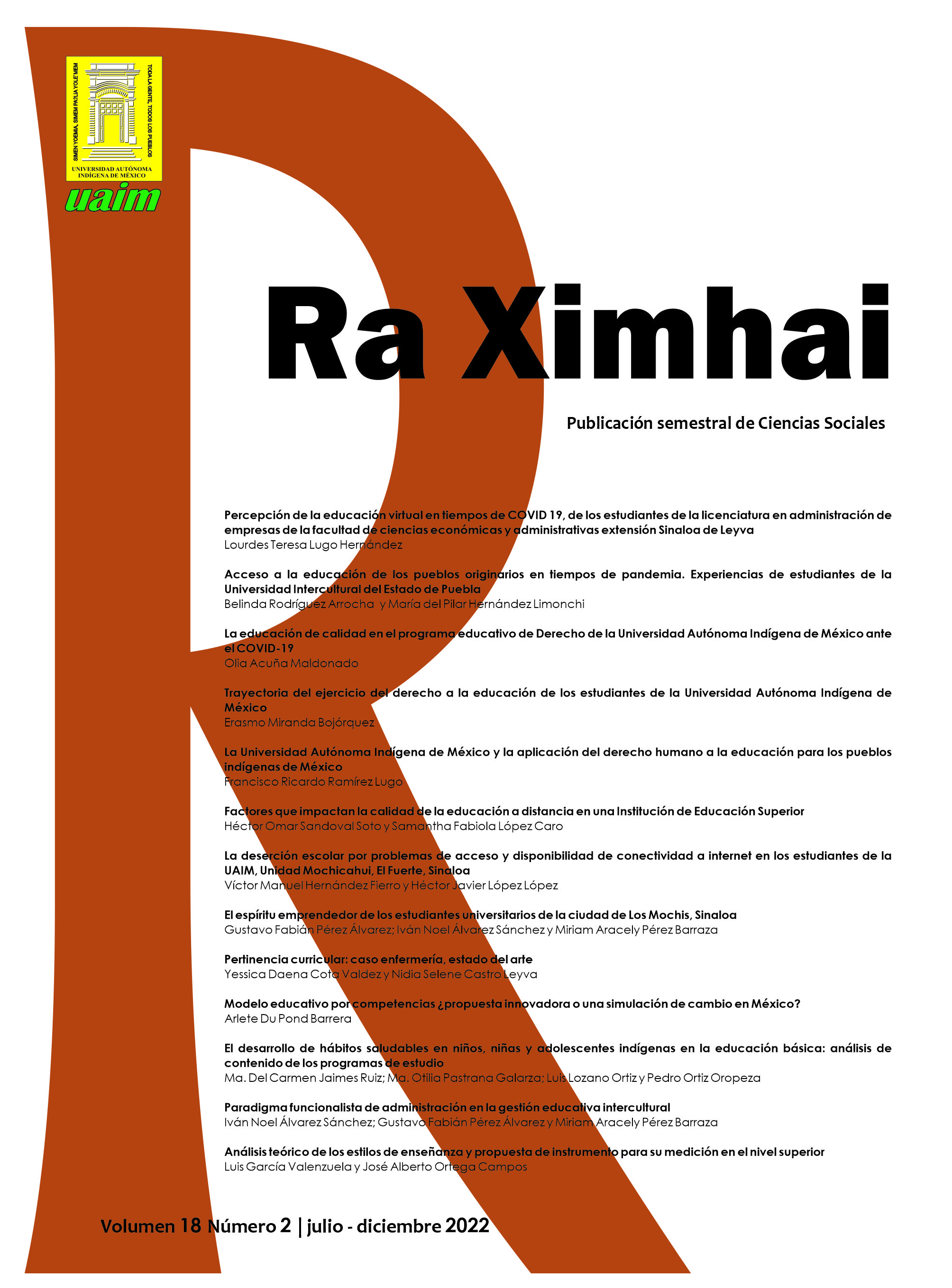The Autonomous Indigenous University of Mexico and the application of the human right to education for the indigenous peoples of Mexico
DOI:
https://doi.org/10.35197/rx.18.02.2022.05.frKeywords:
indigenous peoples, human rights, educationAbstract
The founding of the Autonomous Indigenous University of Mexico (UAIM) was intended to respond to the need of the members of the indigenous peoples of the north of the country to access their human right to quality higher education.
The anthropologist Jesús Ángel Ochoa Zazueta, founder of the UAIM, commented that the indigenous peoples who live in the north of Mexico did not enjoy - to put it in legal terms - their right to education, since by knowing first-hand the problems that these peoples face, by traveling and dealing with them for years, Ochoa was able to document and break down these problems, highlighting the lack of access to higher education for the members of these peoples. This lack of access to quality higher education still persists as we have documented and report in this document.
The violation of the human right to education committed by the Mexican State against indigenous youth living in the north of the state of Sinaloa is due to several factors: One is that indigenous youth do not have sufficient economic resources to cover the costs of pursuing a degree; we report that this is the factor that has the most influence on the lack of access to this type of education.
Another factor is due to the great distances between the indigenous towns and communities where these youth live and the universities that, in the states of Sinaloa and Sonora, Mexico, are located in medium-sized cities.
We were able to identify as a factor that prevents access to quality higher education, the high cost of public transportation and the scarcity of units that provide the service in an efficient and accessible manner between indigenous towns and communities and the places where universities are located. It is worth noting that, in the state of Sinaloa, public transportation is one of the most expensive in the world, if we consider the cost of the ticket/distance traveled indicators.
In light of this situation and to solve the problem of the lack of access to higher education for young members of the indigenous peoples of northern Mexico, such as the Yoreme-Mayo, Yoreme-Yaqui, Guarijios and Koncak, the Autonomous Indigenous University of Mexico (UAIM) was founded in 2001.
Since its founding, the UAIM has implemented an educational model based on research and complied with the provisions of articles 1, 2 and 3 of the Political Constitution of the United Mexican States that refer to indigenous peoples and education.
Thus, the UAIM, in order to ensure that young indigenous people who wished to pursue a degree, were able to access their human right to education without restrictions, by not applying any type of admission exam, in addition to granting them scholarships for lodging, food and exempting them from paying tuition fees.
Despite the efforts of UAIM and other higher education institutions located in the north of the state of Sinaloa, young members of indigenous communities still do not have access to quality higher education, as we report in this essay.
Downloads
References
Carbonell, M. (2006). Los derechos fundamentales en México. Ciudad de México, México. Editorial Porrúa, Universidad Nacional Autónoma de México, Comisión Nacional de los Derechos Humanos.
Consejo Nacional de Evaluación Política de Desarrollo Social CONEVAL. (2017). ¿Qué resultados buscan lograr los programas sociales en Mexico? Informe de enfoque de resultados 2017. Recuperado de https://www.coneval.org.mx/InformesPublicaciones/Documents/Informe-de-Enfoque-de-Resultados-2017.pdf
Giroux, H. A. (1985). Teorías de la reproducción y la resistencia en la nueva sociología de la educación: un análisis crítico. Ciudad de México, México. Editorial Era.
Gramsci, A. (1973). La alternativa pedagógica. Barcelona, España. Editorial Nova Terra.
McCarthy, B. (2000). About Teaching. 4Mat in the Classroom. Recuperado de https://www.amazon.com.mx/About-Teaching-Classroom-Bernice-McCarthy/dp/1929040016?asin=B003X4KY24&revisionId=5d460e64&format=1&depth=1
Rawls, J. (1971). Teoría de la justicia. Ciudad de México, México. Editorial Fondo de Cultura Económica.
Sandoval Forero, E. A.; Guerra García, E.; Ruiz Martínez, F. (2012). Políticas públicas para la inclusión de las comunidades indígenas de Sinaloa en la sociedad de la información. Ciudad de México, México. Editoriales UPN, UAIM y Del Lirio.
Tourine, A. (2000). ¿podremos vivir juntos?: Iguales y diferentes. Ciudad de México, México. Fondo de Cultura Económica.
Vega Acuña, J. –Coordinador–; Galaviz Armenta, H.; Guerra García, E.; Ochoa Zazueta, J. Á.; Valdez Acosta, M. de J. (1999). Mochicahui, Nuevas Fronteras. Mochicahui, El Fuerte, Sinaloa, México. Editorial Instituto de Antropología, Universidad. Universidad de Occidente. Gobierno del Estado de Sinaloa. Comisión para la Atención de los Pueblos Indígenas de Sinaloa.
Wolters, K. (s/f). Sociologismo jurídico y realismo jurídico. Recuperado https://guiasjuridicas.wolterskluwer.es/Content/Documento.aspx?params=H4sIAAAAAAAEAMtMSbF1jTAAAUNTS1MDtbLUouLM_DxbIwMDC0NDQwuQQGZapUt-ckhlQaptWmJOcSoAhC0p_zUAAAA=WKE#:~:text=%E2%80%A2-,La%20concepci%C3%B3n%20sociologista%20del%20Derecho%20parte%20del%20entendimiento%20de%20%C3%A9ste,realidad%20en%20la%20que%20opera.&text=%E2%80%A2-,El%20realismo%20jur%C3%ADdico%20se%20inserta%20dentro%20de%20la%20corriente,la%20que%20prima%20la%20eficacia.
Downloads
Published
How to Cite
Issue
Section
License
Copyright (c) 2022 Francisco Ricardo Ramírez Lugo

This work is licensed under a Creative Commons Attribution-NonCommercial 4.0 International License.
Usted es libre de:
- Compartir — copiar y redistribuir el material en cualquier medio o formato
- Adaptar — remezclar, transformar y construir a partir del material
- La licenciante no puede revocar estas libertades en tanto usted siga los términos de la licencia
Bajo los siguientes términos:
- Atribución — Usted debe dar crédito de manera adecuada , brindar un enlace a la licencia, e indicar si se han realizado cambios . Puede hacerlo en cualquier forma razonable, pero no de forma tal que sugiera que usted o su uso tienen el apoyo de la licenciante.
- NoComercial — Usted no puede hacer uso del material con propósitos comerciales .
- No hay restricciones adicionales — No puede aplicar términos legales ni medidas tecnológicas que restrinjan legalmente a otras a hacer cualquier uso permitido por la licencia.








